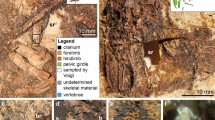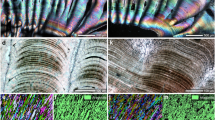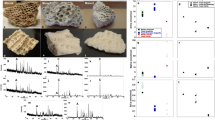Abstract
THE Santana Formation (Lower Cretaceous, Aptian/Lower Albian) of Ceara, Brazil, contains many exceptionally preserved fish fossils within carbonate concretions1,2. These concretions formed before compaction of the sediment and nucleated around carcasses of fish killed in mass-mortality events. Some concretions may contain several fish, preserved in three dimensions with fully articulated skeletons1. A few specimens contain calcium phosphate in the form of cryptocrystalline hydroxyapatite. This occurs as coatings on bones and as a replacement of tissues. Samples of mineralized soft tissues can easily be liberated from the concretions by immersion in 10% acetic acid3. Of several mineral phases often preserving soft tissues, calcium phosphate and silica probably offer the greatest resolution of detail4. Fossilized soft tissues are most frequently found in fishes, although in the Santana Formation pterosaur wing membrane5 and the cuticles of arthropods6,7 have been reported. I report here the study of striated muscle tissue from a fossil elopomorph fish8 from this formation, in which subcellular ultrastructural features are distinguishable. The exceptional degree of preservation of the specimen raises interesting questions about the mechanism of fossilization.
This is a preview of subscription content, access via your institution
Access options
Subscribe to this journal
Receive 51 print issues and online access
$199.00 per year
only $3.90 per issue
Buy this article
- Purchase on Springer Link
- Instant access to full article PDF
Prices may be subject to local taxes which are calculated during checkout
Similar content being viewed by others
References
Martill, D. M. Palaeontology 31, 1–18 (1988).
Mabesoone, J. M. & Tinoco, I. M. Palaeogeogr. Palaeoclimatol. Palaeoecol. 14, 97–118 (1973).
Muller, K. J. Phil. Trans. R. Soc. B311, 67–73 (1985).
Voigt, E. Cour. Forsch. Inst. Senckenberg 107, 325–343 (1988).
Martill, D. M. & Unwin, D. M. Nature 340, 138–140 (1989).
Bate, R. Palaeontology 15, 379A–393 (1972).
Cressey, R. & Boxshall, G. Micropalaeontology 35, 150–167 (1989).
Forey, P. L. Bull. Br. Mus. nat. Hist. 28, 123–204 (1977).
Martill, D. M. & Harper, E. Palaeontology 33, 423–428 (1990).
Brett, C. E. & Baird, G. C. Palaios 1, 207–227 (1986).
Seilacher, A., Reif, W.-E. & Westphal, F. Phil. Trans. R. Soc. B311, 5–23 (1985).
Allison, P. A. Paleobiology 14, 331–334 (1989).
Glimcher, M. J. Phil. Trans. R. Soc. B304, 479–508 (1984).
Soudry, D. Sedimentology 34, 641–660 (1987).
Shapiro, J. Science 155, 1269–1271 (1967).
Willems, H. & Wuttke, M. N. Jb. Geol. Palaeont. Abh. 174, 261–281 (1987).
Author information
Authors and Affiliations
Rights and permissions
About this article
Cite this article
Martill, D. Macromolecular resolution of fossilized muscle tissue from an elopomorph fish. Nature 346, 171–172 (1990). https://doi.org/10.1038/346171a0
Received:
Accepted:
Issue Date:
DOI: https://doi.org/10.1038/346171a0
This article is cited by
-
Palaeobiology of red and white blood cell-like structures, collagen and cholesterol in an ichthyosaur bone
Scientific Reports (2017)
-
Deciphering pyritization-kerogenization gradient for fish soft-tissue preservation
Scientific Reports (2017)
-
Fibres and cellular structures preserved in 75-million–year-old dinosaur specimens
Nature Communications (2015)
-
A simulation experiment on phosphatized spherical microfossils
Chinese Science Bulletin (2014)
-
Cambrian nervous wrecks
Nature (2012)
Comments
By submitting a comment you agree to abide by our Terms and Community Guidelines. If you find something abusive or that does not comply with our terms or guidelines please flag it as inappropriate.



